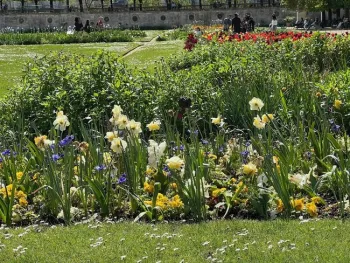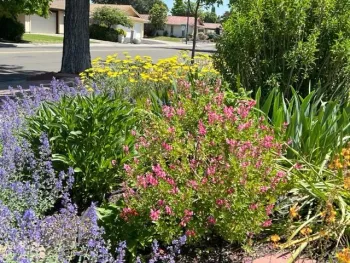I recently had the pleasure of enjoying gorgeous perennial borders in Paris and was inspired! I had visions of taking out some lawn and going all in. But it is always best to study and learn first, and in this case, share with others.
We often think of flower borders as a row or two of flowers in front of some shrubs but borders in France and England tend to be 6-8' wide, filled with flowers, and accessible from both sides. This allows a range of plants to provide varying heights and continuous blooms. In smaller yards with limited space, a lot can be done with a 2-3' wide perennial bed, a corner bed, or an island bed.
As with any garden area, there are basics to consider: site and sun, soil requirements, plants and plant requirements, and care and maintenance. With perennial flower borders, there's also the fun of designing for a progression of blooms and textures.
Sun, Site, and Soil

Especially with wider borders, select a place that will be accessible from at least two sides. If that can't be arranged, leave room for stepping stones to reach all areas without compacting the soil. Although tempting, avoid planting under the base of a mature tree, due to the competition with roots and the deep shade.
Most garden plants need well-drained soil, and perennial flowers are no exception. Soil that is less than ideal can be amended with compost to improve its drainage capacity.
Plants and Plant Requirements
The plants chosen should all have about the same requirements for sun, water, and soil type. In the often drought-stricken Central Valley, it is best to choose plants that have low to moderate water needs once established. Fortunately, many perennials meet these qualifications. Most perennials will last many years and establish themselves fairly quickly.
To get an idea of some of the many perennials, a good resource is the table of Herbaceous Perennials by the Colorado State University Extension. It includes color, bloom period, height, names/cultivars, and comments on a wide variety of perennial flowers for both sun and sun to part shade. While not all may be suitable to the Central Valley climate, many on the list are familiar to valley gardeners.
Designing the Garden
Once you have a site, it's time to design. Straight lines are more formal, while a curved site could be more informal and add interest. One way to map out a curved site is by placing a garden hose on the proposed edges to see if the shape is pleasing. Measure the proposed site and sketch it to scale on graph paper.

Choose a color scheme you like, and combine plants with different forms, textures, colors, and bloom times. Place plants of the same variety in odd-numbered groups of at least three, and repeat the grouping elsewhere to create continuity, using diagonal or triangular spacing. Add in some bulbs for early interest and consider leaving some spaces for seasonal annuals. Since many perennials die back in winter, some seasonal annuals perk up the winter garden. The gardens in Paris had both pansies and primroses for added color.
Leave sufficient room for the mature size of the plants. One thing I noticed in the 8' wide borders in Paris is that they were packed, with peonies pushing up through spent early bulbs and plants close together. However, agricultural extension research discourages planting too close, as the plants need good air circulation to avoid diseases such as powdery mildew.
Once you have a list of possibilities, check a good nursery to see what's available. Patience may be required—not all the plants you want will be available when you want them. For example, Gaillardia (Blanket Flower) is available late spring to summer, but bulbs are most plentiful in the fall. Be flexible and willing to plant in waves or substitute different plants. With a to-scale site on graph paper, the proposed plants can be moved around (at their mature size) to see how it works.
Most of all, enjoy. A perennial garden is a thing of beauty, giving constantly changing views. Most likely, not everything will turn out exactly as planned. A plant may die, or not work as expected. Flexibility and the willingness to experiment will keep the garden vibrant and alluring.
For Further Reading:
Flower Garden Design Basics
Herbaceous Perennials, Fact Sheet 7.405
Perennial Gardening, Fact Sheet 7.402
Using Texture in Flower Gardens

